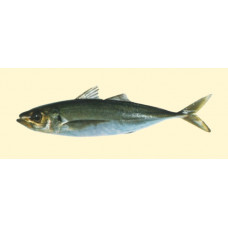Latin name
Trachurus declivis
Other name
Chows, cowan young, greenback horse mackerel, greenback scad, horse mackerel, common jack mackerel, scad, scaly mackerel
Identification
Greek, trachys, -eia, -ys = rough + Greek, oura = tail.
The common name comes from the legend that other smaller fish species can travel long distances on their backs.
Adults are elongated and slightly compressed, with a main lateral line of 71-89 scales and a secondary lateral line extending to 7-9 dorsal fin rays. Vertebrae: 24.
Features of fish fins
Dorsal spines (total): 9; Dorsal soft rays (total): 29 - 35; Anal spines: 3; Anal soft rays: 24 - 29.
Fish colouring
The fish is dark blue-green on top and silvery or grey underneath.
Distribution
Widespread in the southwest Pacific: from Western Australia to New South Wales, including New Zealand. Principal component analysis of morphometric and meristic characters suggests three distinct subpopulations in the Great Australian Bight, off New South Wales and Tasmania.
Habitat
A marine benthopelagic species that prefers brackish waters and temperate climates. Its usual depth range is 27-460m.
Size
Males of this species reach 64 cm in length. The total length is 42 cm. The reported maximum age is 25 years.
Behavior
Adults are usually found near the bottom, in mid-water and occasionally on the surface in continental shelf waters. They form pelagic schools for most of the year, but may move close to the seabed in winter. They are usually found at depths of less than 300 m when water temperatures are below 16°C. Juveniles inhabit coastal waters and estuaries, although they can sometimes be found offshore.
Food and feeding habits
Adults feed mainly on krill and other planktonic crustaceans, light fish (Sternoptychidae) and lanternfish (Myctophidae) on the edge of the continental shelf.
Reproduction
Eggs and sperm are caught in schools of fish, possibly deep in the water column near the edge of the continental shelf. Eggs are distributed between the surface and the thermocline, and larvae are carried to the coast by currents.
Fishing
It is an important commercial and recreational fish. Commercially, it is caught using trawls, purse seines, traps and on-line gear.
Relationship with a person
Harmless. The flesh of these fish has a pleasant flavour.
| Classification | |
| Phylum | Chordata |
| Class | Actinopterygii |
| Squad | Carangiformes |
| Family | Carangidae |
| Genus | Trachurus |
| Species | T. declivis |
| Features | |
| Conservation status | Least Concern |
| Habitat | Pelagic |
| Life span, years | 25 |
| Maximum body weight, kg | No information |
| Maximum length, cm | 64 |
| Sailing speed, m/s | No information |
| Threat to people | Edible |
| Way of eating | Planktonophage |
Greenback horse mackerel
Tags: greenback horse mackerel

